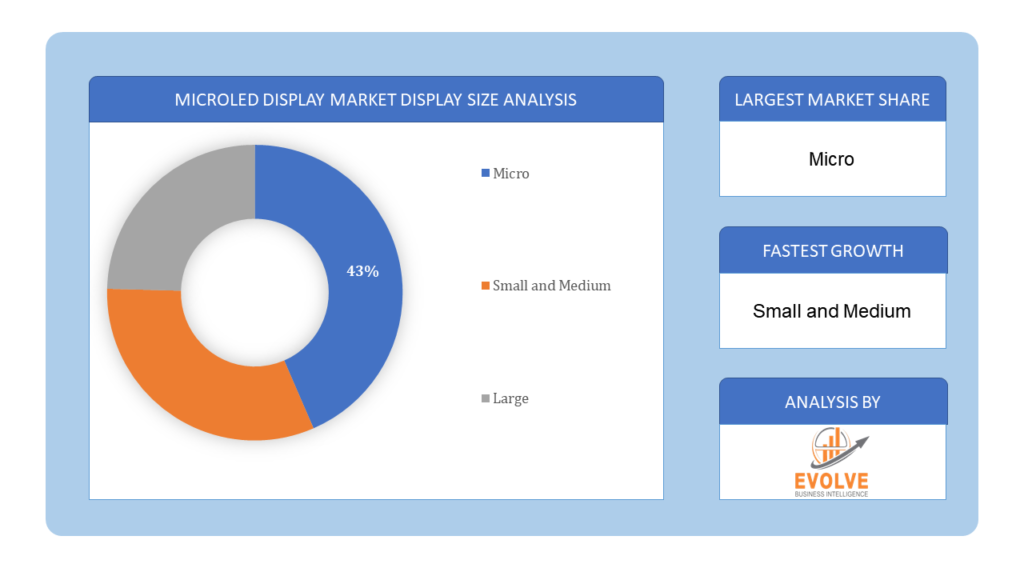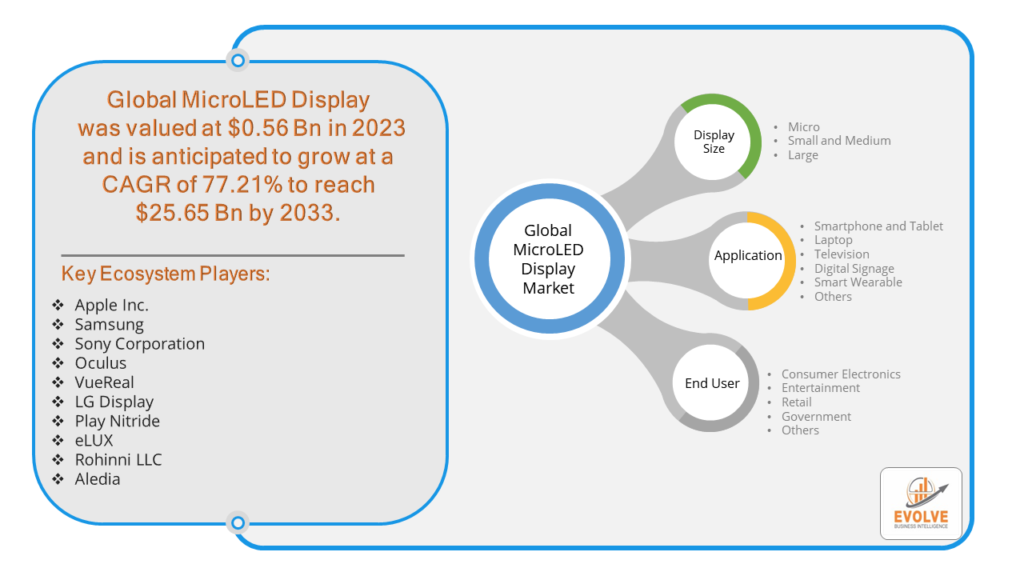MicroLED Display Market Overview
The MicroLED Display Market Size is expected to reach USD 25.65 Billion by 2033. The MicroLED Display industry size accounted for USD 0.56 Billion in 2023 and is expected to expand at a CAGR of 77.21% from 2023 to 2033. MicroLED display is an advanced display technology that utilizes microscopic light-emitting diodes (LEDs) to create images on screens. Each pixel in a MicroLED display is composed of individual, tiny LEDs, which emit light independently to produce vibrant colors and high-resolution images. MicroLED displays offer several advantages over traditional display technologies, including higher brightness, better contrast ratios, wider color gamut, faster response times, and lower power consumption. Due to their superior performance and versatility, MicroLED displays are considered a promising solution for various applications, including televisions, smartphones, smartwatches, augmented reality (AR) and virtual reality (VR) devices, digital signage, and automotive displays.
Global MicroLED Display Market Synopsis
The MicroLED Display market experienced a moderate impact during the COVID-19 pandemic. While the initial disruptions in supply chains and manufacturing processes led to delays in production and deployment, the market showed resilience due to increasing demand for high-quality displays in remote work setups, online education, and home entertainment. Additionally, the pandemic accelerated digital transformation trends, leading to heightened interest in innovative display technologies like MicroLED. However, challenges such as economic uncertainty and reduced consumer spending temporarily slowed down market growth. Overall, the MicroLED Display market navigated through the pandemic with a moderate impact, adapting to changing market dynamics and consumer behavior.
Global MicroLED Display Market Dynamics
The major factors that have impacted the growth of MicroLED Display are as follows:
Drivers:
⮚ Increasing Demand for High-Quality Displays
The growing demand for high-quality displays with superior performance characteristics such as high brightness, wide color gamut, and low power consumption. This demand is fueled by various applications including consumer electronics, automotive displays, digital signage, and AR/VR devices, where MicroLED technology offers significant advantages over traditional display technologies.
Restraint:
- High Manufacturing Costs
The high manufacturing costs associated with the production of MicroLED panels. The intricate process of manufacturing MicroLED displays involves the precise placement of millions of microscopic LEDs, which requires advanced manufacturing equipment and techniques. Additionally, the low yield rates during the manufacturing process can further escalate costs, making MicroLED displays more expensive compared to other display technologies.
Opportunity:
⮚ Emerging Applications and Innovations
An opportunity for the MicroLED Display market lies in the emergence of new applications and innovations that leverage the unique capabilities of MicroLED technology. As the technology matures and becomes more cost-effective, new opportunities arise in various sectors such as automotive, healthcare, gaming, and wearables. Furthermore, ongoing research and development efforts aimed at improving manufacturing processes, increasing yield rates, and reducing production costs present opportunities for market expansion and adoption of MicroLED displays in a wider range of applications.
MicroLED Display Market Segment Overview
By Display Size
 Based on the Display Size, the market is segmented based on Micro, Small, and Medium, Large. The Micro segment was anticipated to lead the MicroLED Display market due to its potential for creating ultra-small display panels suitable for applications such as smartwatches, augmented reality (AR) glasses, and other wearable devices. This segment is driven by the demand for compact and lightweight displays with high resolution and energy efficiency, aligning with the requirements of portable and wearable electronics.
Based on the Display Size, the market is segmented based on Micro, Small, and Medium, Large. The Micro segment was anticipated to lead the MicroLED Display market due to its potential for creating ultra-small display panels suitable for applications such as smartwatches, augmented reality (AR) glasses, and other wearable devices. This segment is driven by the demand for compact and lightweight displays with high resolution and energy efficiency, aligning with the requirements of portable and wearable electronics.
By Application
Based on the Application, the market has been divided into Smartphones and tablets, laptops, Television, Digital Signage, Smart Wearables, and Others. The Smartphone and Tablet segment is expected to dominate the MicroLED Display market, primarily driven by the increasing demand for high-resolution, energy-efficient displays with vibrant colors and superior image quality in portable devices. This segment is further fueled by the growing adoption of smartphones and tablets worldwide, coupled with advancements in MicroLED technology enabling thinner, lighter, and more power-efficient displays, meeting the evolving expectations of consumers for premium mobile viewing experiences.
By End User
Based on End Users, the market has been divided into Consumer Electronics, Entertainment, Retail, Government, and Others. The Consumer Electronics segment is positioned to capture the largest market share in the MicroLED Display market due to the escalating demand for high-quality displays in televisions, smartphones, tablets, and smartwatches. This dominance is driven by the increasing consumer preference for immersive viewing experiences, coupled with advancements in MicroLED technology offering superior brightness, color accuracy, and energy efficiency, aligning with the requirements of premium consumer electronics.
Global MicroLED Display Market Regional Analysis
Based on region, the market has been divided into North America, Europe, Asia-Pacific, the Middle East & Africa, and Latin America. The area of North America is anticipated to dominate the market for the usage of MicroLED Display, followed by those in Asia-Pacific and Europe.
MicroLED Display North America Market
North America asserts dominance in the MicroLED Display market due to several factors. Firstly, the region is home to a robust ecosystem of technology companies and research institutions driving innovation in display technologies. Secondly, high disposable incomes and a strong demand for premium consumer electronics fuel adoption. Lastly, strategic partnerships between industry players and government support further consolidate North America’s position as a leader in MicroLED Display technology.
MicroLED Display Asia Pacific Market
The Asia-Pacific region has witnessed remarkable growth in the MicroLED Display market attributed to several key factors. Firstly, the region boasts a thriving consumer electronics industry, particularly in countries like China, South Korea, and Japan, driving demand for high-quality displays. Secondly, Asia-Pacific’s manufacturing prowess and technological innovation contribute to the development and production of MicroLED displays. Lastly, increasing investments in research and development, coupled with favorable government policies, foster innovation and market growth in the region.
Competitive Landscape
The competitive landscape includes key players (tier 1, tier 2, and local) having a presence across the globe. Companies such as Apple Inc., Samsung, Sony Corporation, Oculus, and VueReal are some of the leading players in the global MicroLED Display Industry. These players have adopted partnership, acquisition, expansion, and new product development, among others as their key strategies.
Key Market Players:
- Apple Inc.
- Samsung
- Sony Corporation
- Oculus
- VueReal
- LG Display
- Play Nitride
- eLUX
- Rohinni LLC
- Aledia
Key Development
January 2024 – Innolux Corp (Innolux) unveiled the world’s pioneering 53-inch QD color conversion AM-Micro LED seamless tiling displays, designed for seamless assembly of displays of any size utilizing seamless tiling module technology. This innovative technology addresses the escalating market demand for high-quality, ultra-wide, and ultra-tall displays ranging from 110 to 200 inches in size. The seamless tiling solution delivers exceptional color saturation and uniformity, surpassing OLED by 1.07 times, along with a superior ambient contrast ratio that is eight times higher than OLED, even in standard lighting conditions.
September 2023 – Sony debuted VERONA, a cutting-edge Crystal LED display crafted to cater to the demands of virtual production applications, presenting filmmakers with heightened levels of quality and efficiency for in-camera VFX applications.
Scope of the Report
Global MicroLED Display Market, by Display Size
- Micro
- Small and Medium
- Large
Global MicroLED Display Market, by Application
- Smartphone and Tablet
- Laptop, Television
- Digital Signage
- Smart Wearable
- Others
Global MicroLED Display Market, by End User
- Consumer Electronics
- Entertainment
- Retail
- Government
- Others
Global MicroLED Display Market, by Region
- North America
- US
- Canada
- Mexico
- Europe
- UK
- Germany
- France
- Italy
- Spain
- Benelux
- Nordic
- Rest of Europe
- Asia Pacific
- China
- Japan
- South Korea
- Indonesia
- Austalia
- Malaysia
- India
- Rest of Asia Pacific
- South America
- Brazil
- Argentina
- Rest of South America
- Middle East & Africa
- Saudi Arabia
- UAE
- Egypt
- South Africa
- Rest of Middle East & Africa
| Parameters | Indicators |
|---|---|
| Market Size | 2033: $25.65 Billion |
| CAGR | 77.21% CAGR (2023-2033) |
| Base year | 2022 |
| Forecast Period | 2023-2033 |
| Historical Data | 2021 |
| Report Coverage | Revenue Forecast, Competitive Landscape, Growth Factors, and Trends |
| Key Segmentations | Display Size, Application, End-User |
| Geographies Covered | North America, Europe, Asia-Pacific, Latin America, Middle East, Africa |
| Key Vendors | Apple Inc, Samsung, Sony Corporation, Oculus, VueReal, LG Display, Play Nitride, eLUX, Rohinni LLC, Aledia |
| Key Market Opportunities | • Emerging applications and innovations leveraging MicroLED technology. • Growing adoption of MicroLED displays in sectors such as consumer electronics, automotive, and healthcare. |
| Key Market Drivers | • Increasing demand for high-quality displays across various applications. • Advancements in MicroLED technology lead to improved performance and efficiency. |
REPORT CONTENT BRIEF:
- High-level analysis of the current and future MicroLED Display Industry trends and opportunities
- Detailed analysis of current market drivers, restraining factors, and opportunities analysis in the future
- Historical market size for the year 2021, and forecast from 2023 to 2033
- MicroLED Display market share analysis for each segment
- Competitor analysis with a comprehensive insight into its product segment, financial strength, and strategies adopted.
- Identifies key strategies adopted by the key players including new product development, mergers and acquisitions, joint ventures, collaborations, and partnerships.
- To identify and understand the various factors involved in the global MicroLED Display market affected by the pandemic
- To provide year-on-year growth from 2022 to 2033
- To provide short-term, long-term, and overall CAGR comparison from 2022 to 2033.
- Provide Total Addressable Market (TAM) for the Global MicroLED Display Market.






